- Учителю
- Доклад-реферат к проекту Почему мы танцуем? 11 класс
Доклад-реферат к проекту Почему мы танцуем? 11 класс
Восточное окружное управление
Образования Департамента
г. Москвы
Государственное бюджетное общеобразовательное учреждение города Москвы «Гимназия № 1811 «Восточное Измайлово»»
The science practical conference
"Children are creators of the 21-st century"
Project
« Why do we dance? »
Students: Gorkova L, Larina K, Filateva N
Form 11 "zh"
Teachers: Kukushkina M.A.
Zolotaryova N.A.
Moscow 2015
Contents
Chapter1.
Dancing in ancient times. Dancing: for what?
-
Page4
Chapter2.
Dancing styles
-
Page5
Chapter3.
Outstanding dancers in the world
-
Page6
Chapter4.
Dances in our life
-
Page13
Chapter5
A survey in the school
-
Page14
Conclusion
-
page18
The used literature
-
page18
Introduction
Why Do We Dance?
Why do people dance? They do it for different reasons but probably the most expected answer is that they dance because they simply like it. It is difficult to say when dance became an important part of human culture.
Our project is «Why do we dance?»
The working group consists of the pupils from the 11th form. They are: Filateva Nastya,Gorkova Luba and Larina Ksenya. The teachers: Kukushkina M.A , Zolotaryova N.A.
The aims and tasks of the project:
-
To meet you with different styles of dancing
-
To discuss such questions as What does dances for us in our life?;
Dancing in ancient times.; Dancing: for what?; Outstanding dancers in the world
-
To make a social research in this area
-
To practise English in speaking on the topic
-
To broaden our horizons
To make this project we have learnt a lot of literature, used various information from the Internet resources, made a social survey among classes at school, found topical pictures and videos for the presentation. For making our film we have used new computer technologies and programmes. Then we would like to demonstrate our project on the other science festivals.
Chapter1. Dancing in ancient times. Dancing: for what?
Dance has been used during different ceremonies, rituals and celebrations since prehistoric times. Archeologists have found Egyptian tomb paintings depicting dancing figures from circa 3300 ВС. In the past people danced to tell myths and to show feelings for one of the opposite gender. Dance plays a vital role in many of the world's religions. People have used dance in praise of their gods, in celebration of the seasons, and simply as an outward expression of joy or grief. Native Americans could not imagine their lives without dancing. It was an essential part of their culture and heritage. Native Americans danced for almost any reason: for worship, for rain, when preparing to fight with other tribes or when preparing for a big hunt.
Today a lot of people are still fond of dancing though few of them dance for religious reasons. For many of us dance is an excellent opportunity to have fun, to express our emotions, to relieve stress, to experience music and to improve our health and fitness level. Dance can be also a form of nonverbal communication as it helps two people say 'I love you' to each other. That is why many couples celebrate their unions with a wedding dance which is the symbol of their love and affection. A wedding dance is an unforgettable experience and a person remembers this happy moment during all his or her life.
Chapter 2. Dancing styles
There are many interesting dancing styles and everybody can find something to his liking. There are dancing styles that can be practiced alone (solo dance), as a couple (partner dance), or as a part of a much larger group (group dance).
Ballet is popular with many people and it is best known for its unique features and techniques. Ballet began to develop in Italy and later it appeared in France. It combines classical music, mime, acting, costumes and dance. Nobody can remain indifferent watching ballet dancers' graceful movements.
The waltz is a ballroom and folk dance in 3/4 time. It first became fashionable in Vienna around the 1780s and spread to many other countries. This dance form became the example for the creation of many other ballroom dances. In Britain the waltz was considered 'riotous and indecent' as late as 1825. Now there are many types of waltz, including many folk and several ballroom dances.
Tango is often associated with love, passion and romance. This dance form originated in Buenos Aires, Argentina and Montevideo, Uruguay and it became popular in Europe in the early years of the 20th century. Tango has influences from Spanish and African cultures. Today, there are many tango dance styles, including Argentine Tango, Uruguayan Tango, Ballroom tango (American and International styles), Finnish tango, Chinese tango, and vintage tangos.
Today many young people, especially boys, are fond of break dancing. It is a street dance style that evolved as part of the hip hop movement among African American and Latin American youths during the early 1970s. It is normally danced to funk or hip hop music. Break dance is highly improvisational and physically demanding. It allows dancers to display their skills by showing extremely difficult and complicated elements. Some dancers organize competitions and try to outperform each other.
Chapter 3. Outstanding dancers in the world
A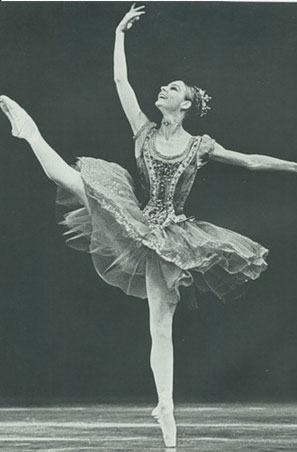 nna Pavlovna
Pavlova (January 31, 1881 (Old Style)/February 12, 1881
(New Style) - January 23, 1931) was the most famous ballet dancer
of the early 20th century.
nna Pavlovna
Pavlova (January 31, 1881 (Old Style)/February 12, 1881
(New Style) - January 23, 1931) was the most famous ballet dancer
of the early 20th century.
Born in St. Petersburg, Russia to a poor peasant family, she
trained at the Imperial Ballet School until she graduated at age
18. Then danced with the Mariinsky Theatre. In the first years of
the Ballets Russes she worked briefly for Serge Diaghilev before
founding her own company and performing throughout the world.
Her most famous showpiece was The Dying Swan choreographed for her
by Michel Fokine. The music piece was the Swan part of Camille
Saint-Saens the Carnival of the Animals.She died of pleurisy in The
Hague, Netherlands while touring. Her remains were recently moved
to the Novodevichy Cemetery in Moscow.
The pavlova dessert was named after her, although its origins are
disputed. Both Australia and New Zealand have claimed the credit.
Rudolf Khametovich Nureyev (17 March 1938 - 6 January 1993),
Russian-born dancer, is regarded by many critics as one of the
greatest male dancers of the 20th century, alongside Vaslav
Nijinsky and Mikhail Baryshnikov.
Nureyev was born in a train near Irkutsk, while his mother was
travelling across Siberia to Vladivostok, where his father, a Red
Army political commissar of Tatar descent, was stationed. He was
raised in a village near Ufa in Soviet Bashkiria. As a child he was
encouraged to dance in Bashkir folk performances and his precocity
was soon noticed.
Due to the disruption of Soviet cultural life caused by World War
II, Nureyev was unable to enroll in a major ballet school until
1955, when he was sent to the Vaganova Choreographic Institute,
attached to the Kirov Ballet in Leningrad. Despite his late start,
he was soon recognised as the most gifted dancer the school had
seen for many years. Already, however, his extremely difficult
temperament was evident. In retrospect it seems obvious that his
personal problems were mainly due to internal conflict over his
sexuality.
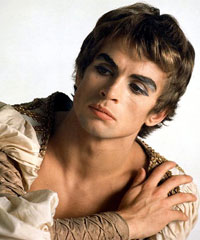
Within two years Nureyev was one of Russia's best-known dancers,
in a country which revered the ballet and made national heroes of
its stars. Soon he enjoyed the rare privilege of travel outside the
Soviet Union, when he danced in Vienna at the International Youth
Festival. Not long after, for disciplinary reasons, he was told he
would not be allowed to go abroad again. He was condemned to tours
of the Russian provinces.
In 1961 Nureyev's luck turned. The Kirov's leading male dancer,
Konstantin Sergeyev, was injured, and at the last minute Nureyev
was chosen to replace him in a performance in Paris. In Paris, his
performances electrified audiences and critics. But Nureyev broke
the rules about mingling with foreigners, and was told he would be
sent home. Realising he would probably not be allowed abroad again,
on 17 June at Charles De Gaulle International Airport, he defected.
He did not see Russia again until 1989, when he visited at the
special invitation of Mikhail Gorbachev.
Within a week Nureyev had been signed up by the Grand Ballet du
Marquis de Cuevas and was performing The Sleeping Beauty with Nina
Vyroubova. Nureyev was an instant celebrity in the west. His
dramatic defection, his outstanding skills, and, it must be said,
his astonishing good looks, made him an international star. This
gave him the power to decide where and with whom he would
dance.
Nureyev's defection also gave him the personal freedom he had been
denied in the Soviet Union. On a tour of Denmark he met Erik Bruhn,
another dancer ten years his senior, who became his lover, his
closest friend and his protector (mainly from his own folly) for
many years. The relationship was a stormy one, for Nureyev was
highly sexually promiscuous. Bruhn was director of the Royal
Swedish Ballet from 1967 to 1972 and Artistic Director of the
National Ballet of Canada from 1983 until his death in 1986. One of
the men that Nureyev is said to have had an affair with was movie
star Anthony Perkins.
At the same time Nureyev met Margot Fonteyn, the leader British
dancer of her time, with whom he formed a professional partnership
and a close friendship. She brought him to the Royal Ballet in
London, which remained his base during the rest of his dancing
career. Together Nureyev and Fonteyn forever transformed such
cornerstone ballets as Swan Lake and Giselle.
Nureyev was immediately in demand by film-makers, and in 1962 he
made his screen debut in a film version of Les Sylphides. In 1976
he played Rudolph Valentino in Ken Russell's film, but he had
neither the talent nor the temperament for a serious acting career.
He branched into modern dance with the Dutch National Ballet in
1968. In 1972 Robert Helpmann invited him to tour Australia with
his own production of Don Quixote, his directorial debut.
During the 1970s, Nureyev appeared in several movies and toured the
United States in a revival of the Broadway musical The King and I.
His guest appearance on the then-struggling television series The
Muppet Show is credited for boosting the series to worldwide
success. In 1982 he became a naturalized Austrian. In 1983 he was
appointed director of the Paris Opera Ballet, where as well as
directing he continued to dance and to promote younger dancers.
Despite advancing illness towards the end of his tenure, he worked
tirelessly, staging new versions of old standbys and commissioning
some of the most groundbreaking choreographic works of his
time.
Nureyev's talent, beauty, and charm caused him to be forgiven many
things, but stardom did little to improve his temperament. He was
notoriously impulsive and did not have much patience with rules,
limitations and hierarchical order. Some saw this as unreliability
and rudeness to those he worked with. He mixed with Jacqueline
Kennedy Onassis, Mick Jagger and Andy Warhol, and developed a
reputation for intolerance of non-celebrities, but he kept up old
friendships in and outside the ballet world for decades, being a
loyal and generous friend. His interests were widespread and he
loved to discuss all kinds of subjects, showing an amazing wealth
of knowledge in many fields. By the end of the 1970s he moved into
his 40s and faced the inevitable decline of his amazing physical
prowess, he unfortunately continued to tackle the big classical
roles for far too long, and his rather undistinguished performances
in the late 1980s disappointed many of his admirers.
Nureyev's influence on the world of ballet changed especially the
perception of male dancers; in his own productions of the classics
the male roles got much more choreography than in earlier
productions. The second very important influence was his crossing
the borders between classical ballet and modern dance by dancing
both, although having been trained as a classical dancer. Today it
is absolutely normal for dancers to get training in both styles but
Nureyev was the one who started this and is was a sensation and
even much criticized in his days.
When AIDS appeared in France in about 1982 (as well as everywhere
else), Nureyev, like many French homosexual men, took little
notice. He presumably contracted HIV at some point in the early
1980s. For several years he simply denied that anything was wrong
with his health: when, in about 1990, he became undeniably ill, he
pretended he had several other ailments. He refused whatever
treatments were available at that time.
Eventually, however, he had to face the fact that he was dying. He
won back the admiration of many of his detractors by his courage
during this period. The loss of his looks pained him, but he
continued to struggle through public appearances. At his last
appearance, at a 1992 production of The Bayadere at the Palais
Garnier, Nureyev received an emotional standing ovation from the
audience. The French Culture Minister, Jack Lang, presented him
with France's highest cultural award, the Chevalier de l'Ordre des
Artes et Lettres. He died in Paris, France, a few months later,
aged 54.
Mikhail Nikolaevitch Baryshnikov was born on January 27, 1948
in Riga, USSR. He bagan studying ballet in 1960, at the age of 12.
In 1964 he entered the Vaganova School to further his ballet
studies. He soon began winning top honors and leading roles in
major ballets. Upon seeing him dance in the Soviet Union, Clive
Barnes, a New York Times critic, called him the most perfect dancer
he had ever seen.
Leaving Russia:
Because the Soviet dance world held fast to 19th century traditions
and shunned creativity, Baryshnikov decided to move west. He first
defected to Canada, then made his way to the United States. During
his first two years away from Russia, he danced for 13 different
choreographers.
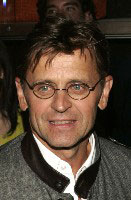
New York City Ballet:
In 1978, Baryshnikov became a principal dancer for the New York
City Ballet, under the direction of George Balanchine. His
distinctive style won him many leading roles, although Balanchine
never created a new work for him. In 1980, he changed his role from
performer to director, becoming Artistic Director of the American
Ballet Theatre.
Film Career:
Baryshnikov began dancing for American television in 1976. In 1977,
CBS brought his production of the Nutcracker at the American Ballet
Theatre to television. The famous production remains the most
popular and most often shown television production of the
Nutcracker Ballet. The DVD of the performance is a bestseller
during the holidays. It is also one of only two versions of "The
Nutcracker" to be nominated for an Emmy Award.
He also portrayed a famous Russian ballet dancer in the 1977 film
The Turning Point, receiving an Oscar nomination. He later starred
in the 1985 film White Nights, and Sex and the City.
Family Life:
Baryshnikov has three children with former ballerina Lisa Rinehart,
although they remain unmarried. He also has a daughter from a
former relationship with actress Jessica Lange.
Chapter 4. Dances in our life
For us life is a dance. We can't imagine ourselves without it. Every movement, swing, turn, makes the world brighter. We have been dancing since the 5th form at school. And it is passion of our life. Dancing is very beautiful and elegant. Dress, heels, hair - what could be more beautiful? Before going on a stage, you feel excitement. But once the music starts to play, once there is a great desire to come out and shows to all that you are capable. Crowds of people are watching your every movement, a smile. And it is a true happiness.
We are trying ourselves to think what movements use, speaking in the language dance.
Every year we take part in different school and afterschool activities and there we demonstrate our skills in dancing.
We not only dance, but we enjoy watching different dancing reality television shows on TV. Such as: Dances with Stars, Dances in TNT, Ice Dances on the first channel, different dancing competitions on musical channel and so on.
Sometimes we take dance lessons or just, buy videos and DVDs that teach different dance steps.
Dance and enjoy the fact that you are doing. Believe me, there are no such people who can't dance. Try, you must succeed. And for someone dance will be a part of the life. Dance to live!
I like to listen to music. I can listen music of all styles, it depends on my mood. But most of all styles about I told You, I like dance. Because this style helps me to relax and make merry with my friends or alone.
Chapter 5. A survey in the school
Dancing plays an important role in people's life. It is difficult to imagine a person, who would not love to dance.
Can you think of a day without dancing? We can dance everywhere: in the streets and at home, in the schools, halls, parks, different grounds in the parks and so on. People all over the world are fond of dancing. They listen to music, they dance to music, they learn to do nice.
We have made a survey in our school among classes. It was asked 5 questions to the pupils.
The first question was 1) Do you like to dance?
The 2nd question was 2) What's your favourite style?
The 3rd question was 3) What are dances for your in your life?
The 4th question was 4) Do you like to take part in school dance festivals or competitions?
The 5th question was 5) Do you watch a dance show on TNT «Dances»?
The results we have got are different. But now we know that :
-
64% like to dance
-
81% like to dance modern styles
-
64% dances are a pleasure hobby in free time
-
61% like to take part in different dance festivals and competitions
-
60% watch a dance show on TNT « Dances»
In general it took part in the survey 167 pupils.
The 1-st question
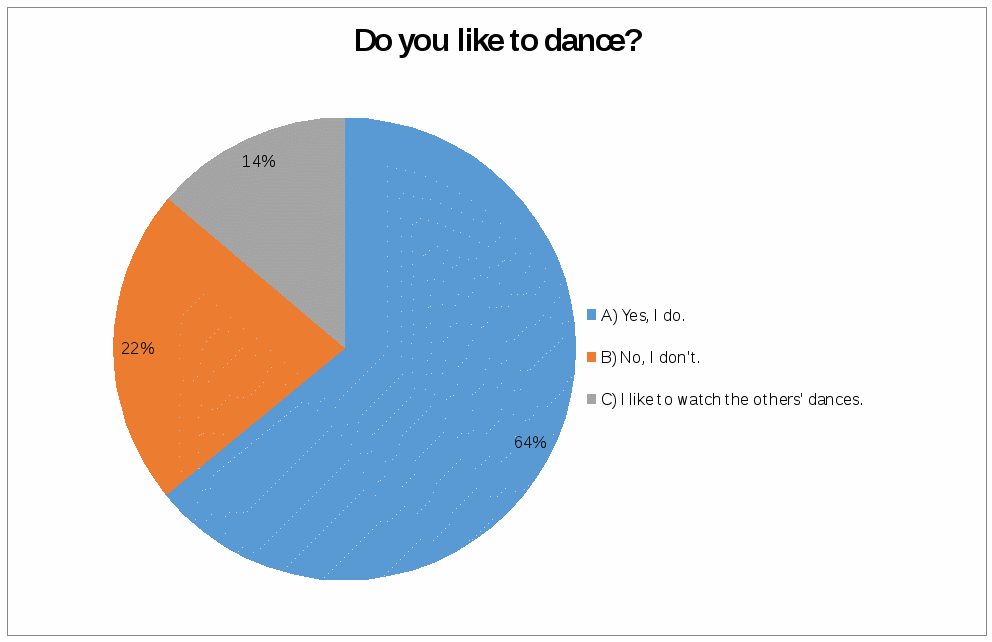
The 2-nd question
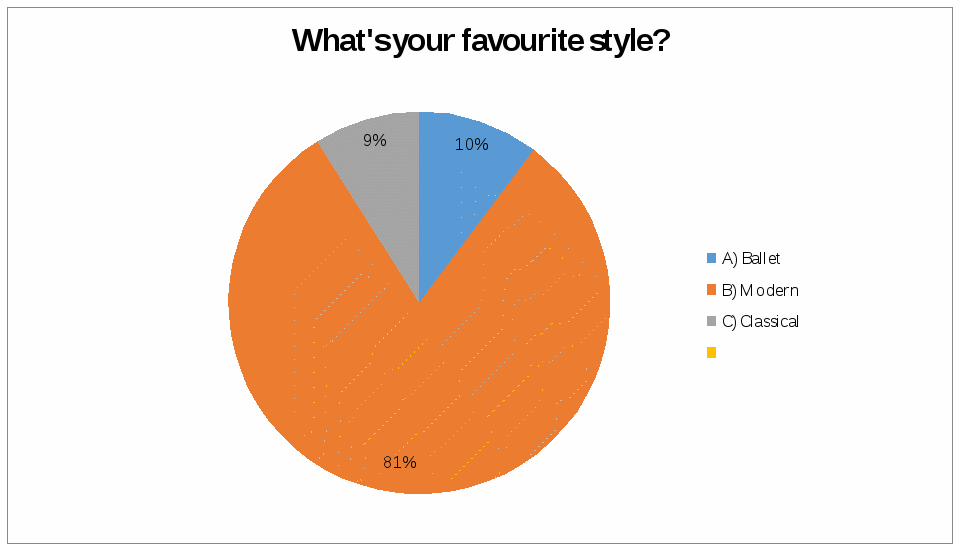
The 3-rd question
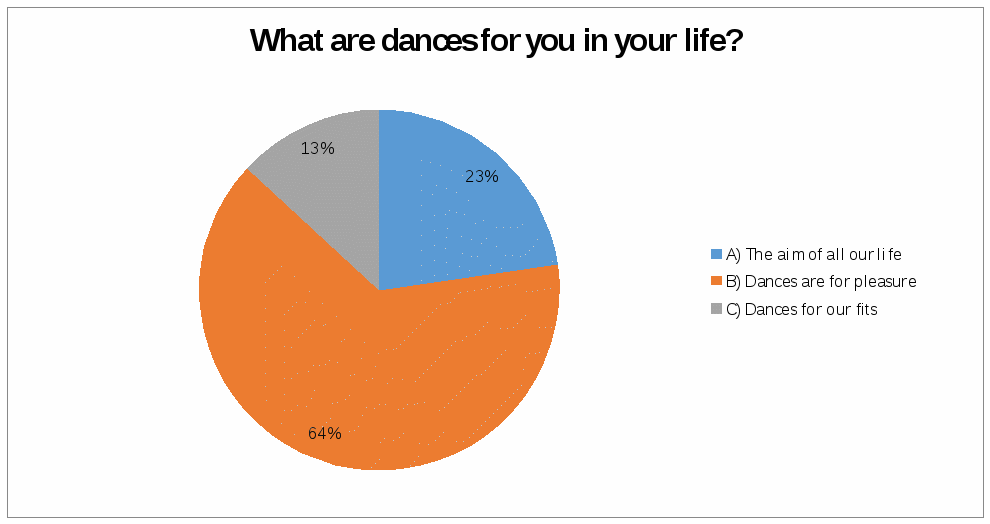
The 4-th question
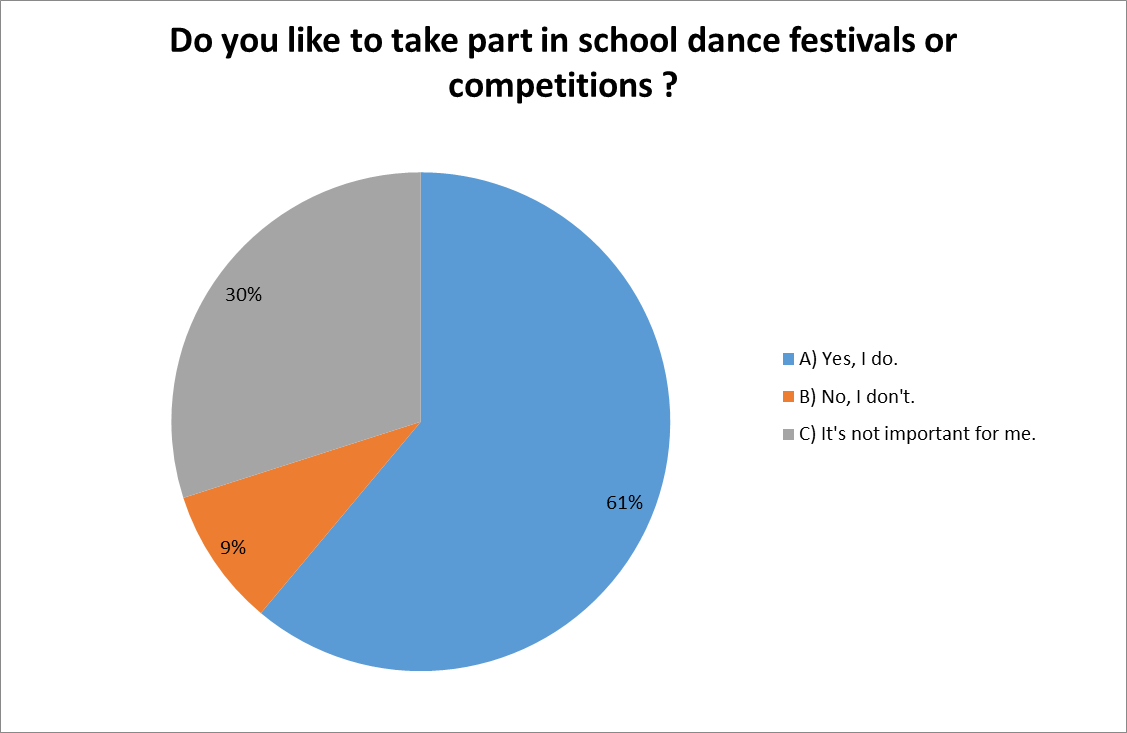 The 5-th
question
The 5-th
question
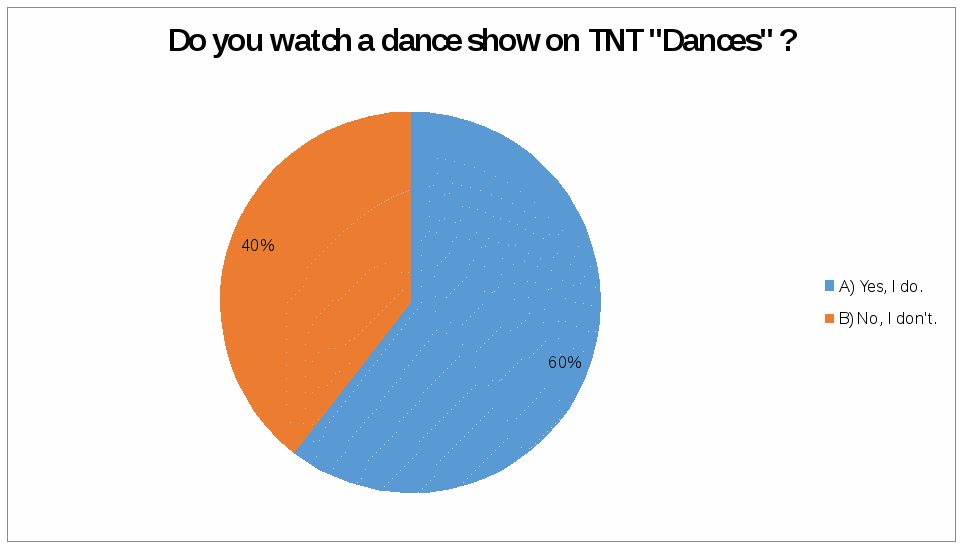
Conclusion
-
Dances plays a very important role in our life. Dancing inspires, enriches our hearts and feelings. It reflects our mood and emotions.
-
Dancing to music is the perfect way to spend free time and not to feel bored.
-
There are such kinds of dances as: ballet, the waltz, tango, break dancing and so on
-
Dancing is beauty in movements, it is our magic source of inspiration.
-
To practice English we communicated with each other in groups and pairs, discussed different questions, problems, information, changed our points of view, made a report, presentation and film on this topic.
-
To make our project we used different sources of information: newspapers, magazines, student books in English- 8-11 by different authors, the Internet, TV-shows, films, videos.
The used literature
-
Выборова Г.Е.; 70 устных тем по английскому языку; Москва «аст-пресс книга», 2005 г.
-
Занина Е.Л.; 95 устных тем по английскому языку; Москва «айрис»,2013 г.
-
Музланова Е.С.; Устные темы, диалоги и упражнения по английскому языку; Москва «Экзамен»,2010 г.
-
Цветкова И.В.; Английский язык для школьников, поступающих в вузы; Москва «Глосса-Пресс»,2005 г.
-
Открывая мир с английским языком. Современные темы для обсуждения. С.А. Юнёва, Москва, «Интеллект-центр», 2014г
-
www.wikipedia.ru</</u>
-
english-4life.com.ua/